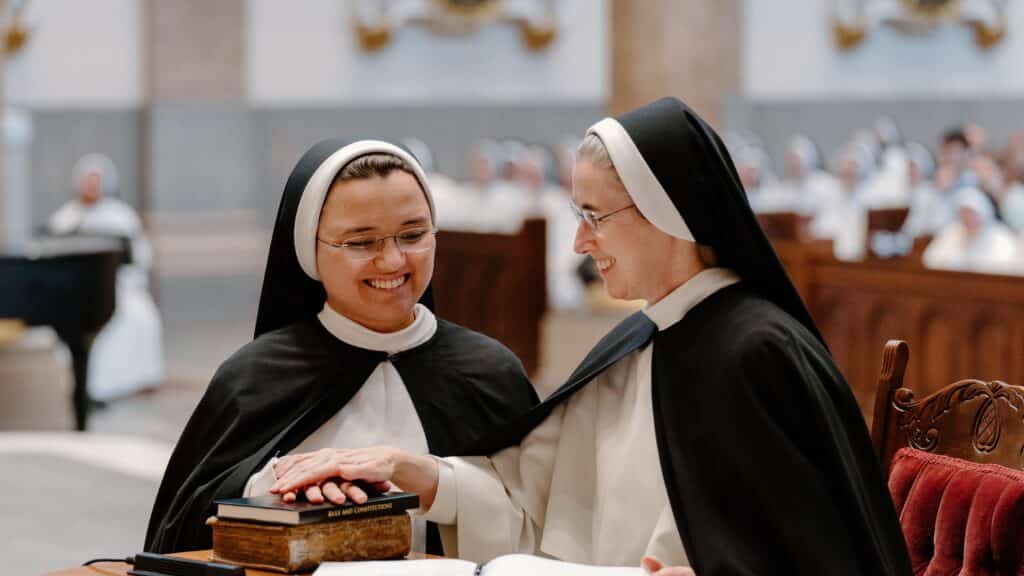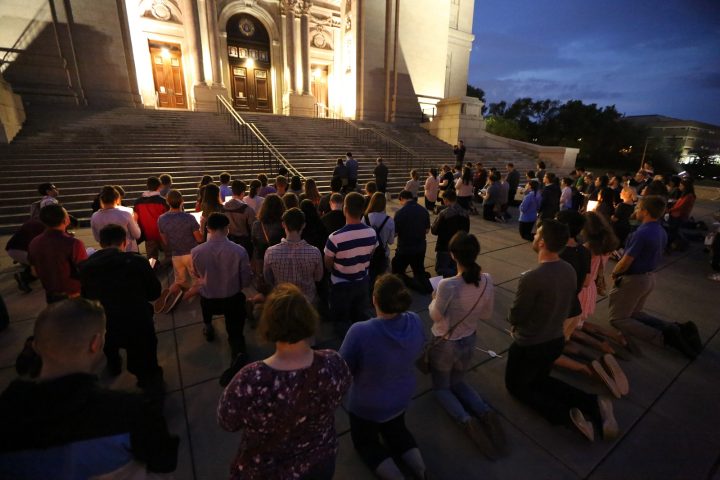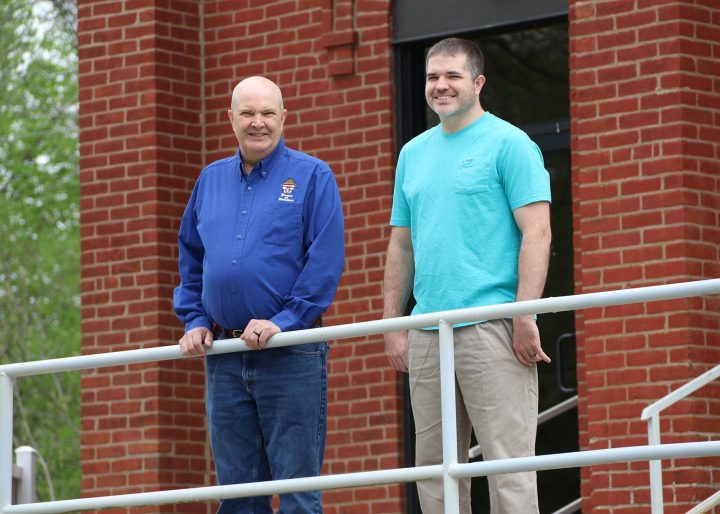
(OSV News) — “Perhaps,” said Father Timothy Radcliffe — preacher, speaker, and former master of the Order of Preachers, commonly known as the Dominicans — “religious orders have something to teach the Church about the art of conversation.”
Offering a three-day retreat to Synod on Synodality participants prior to its Oct. 4 start in Rome, Father Radcliffe cataloged the communication skills of several religious leaders. “St. Benedict teaches us to seek consensus; St. Dominic to love debate; St. Catherine of Siena to delight in conversation; and St. Ignatius of Loyola, the art of discernment,” he told his listeners.
While the Catholic Church is in the midst of understanding and defining synodality, at the heart of the word is basically a process of speaking and listening that actively seeks to include and engage a diversity of voices when contending with collective discussion and decision-making.
So do religious orders “do” synodality in a way the rest of the Catholic Church can learn from?
“I’m still not entirely sure what we mean by synodality,” Dominican Father Thomas Petri, president and assistant professor of moral theology and pastoral studies at the Dominican House of Studies in Washington, told OSV News.
“But if it means sort of a conversation together — and looking at mission, and what God wills us to do, and desires us to do — yes,” Father Petri affirmed, “I think there’s a certain way that religious life does that, inherently and explicitly, that other vocations probably do not.”
The Order of Preachers was founded in France by St. Dominic de Guzmán and approved by the pope in 1216. The Dominicans became — and still are — known for robust preaching and scholarship. There are more than 30,000 Dominican friars, priests and nuns worldwide.
“It’s part and parcel of religious life that we don’t move alone — we always move in tandem with our brothers,” Father Petri explained, adding that coordinated efforts are “the way Dominicans discern and move in the world and through history together — which is to say, always in conversation with each other.”
Community life and structure also contributes to synodality.
“When you’re a religious, you’re sitting at table; you’re having lunch and dinner together all the time. So there is an art of learning how to have a conversation and include everyone at the table,” said Father Petri. “But more importantly, for Dominicans — and I think this is true for most religious — there’s also formal types of conversations, as a community.”
Known as “chapters,” those may take place in the local priory, throughout the province, or for the entire order. “The priory chapter has to meet weekly, and the prior (the superior of a Dominican community) will bring up concerns or comments,” Father Petri shared, “and there will be an opportunity for discussion.”
“This is not something new,” Sister Gemma Simmonds, director of the Religious Life Institute at the Margaret Beaufort Institute of Theology in Cambridge, England, told OSV News. “This is in fact deeply traditional.”
Sister Simmonds’ order, the Congregation of Jesus, is an international congregation of approximately 1,400 active and contemplative religious sisters founded in 1609.
“This whole synodal approach is really consistent with the deepest spiritual traditions within the church. How did they work out what to do at the First Council of Jerusalem?” asked Sister Simmonds, referring to the earliest known gathering of the church’s leaders. Described in Acts 15:1-31, the council is thought to have been held in Jerusalem around A.D. 48-50. “They sat down, and they listened to each other,” Sister Simmonds said, “and they prayed around what they had heard.”
Sister Simmonds was one of four religious order delegates chosen to collate synodal survey responses for congregations of both men and women worldwide, as represented by the Union of Superiors General and International Union of Superiors General. Together, these groups encompass approximately 200 religious orders of men and 2,000 religious orders of women — all of whom were asked to have a mini-synod and produce a report.
“What absolutely blew us away,” Sister Simmonds shared, “was the level of consensus right across the world (among sisters from different continents). … And I think it’s because these are people whose life work is listening out for the voice of the Spirit.”
For religious, it’s a skill acquired and sharpened by year upon year of prayer, and living a communal life.
“People say that they know how to listen,” said Sister Simmonds. “Big news flash: They don’t. Most people — even if they’re in small groups — they’re kind of listening with one ear, but they’re actually thinking up their response.”
Synodality, in contrast, is decidedly intentional — and attentive.
“If people want to know what synodality is,” Sister Simmonds said, “it’s actually first and foremost learning to listen in a way that is truly receptive.”
Sister Maria Cimperman, a professor of Catholic theological ethics at Chicago’s Catholic Theological Union and founding director of the Center for the Study of Consecrated Life, was also part of the four-person synodal review team on which Sister Simmonds served.
A member of the Religious of the Sacred Heart of Jesus, Sister Cimperman’s education-focused order has 1,800 sisters in 41 countries today and was founded in post-Revolutionary France in 1800 by St. Madeleine Sophie Barat.
“When you’re talking about synodality, it’s a way of walking together — but it’s also a way of discernment that’s done together,” Sister Cimperman told OSV News. “Instead of saying, ‘What do you think we should do?’, it’s a much deeper question: ‘What do you sense the Spirit is asking?’”
But, Sister Cimperman explained, synodality also can sometimes be challenging for religious.
“In community, you may go, ‘Ah! That was a really frustrating conversation,’ or you can get upset with somebody. But the call is always to go back to the table; to go back to one another,” she said.
For Father Ed Tlucek, a Franciscan priest who serves two Wisconsin parishes and will soon become provincial councilor for the order’s Our Lady of Guadalupe Province, the Franciscan heritage also is a guide to synodality.
Founded in Italy by St. Francis of Assisi in 1209, the Franciscans — well-known for their embrace of Gospel simplicity, strong identification with the poor and care for creation — today number about 35,000 friars, 60,000 cloistered women religious, and 155,000 “Third Order Regular” religious sisters and brothers.
“It’s in conversation that comes out of living with the brothers — the community environment in which we live — that we are constantly challenged,” Father Tlucek told OSV News. “Not only to share our inner thoughts, but to listen to the other. And then to be willing, in the conversation, to change.”
That model of listening was critical when five U.S. Franciscan provinces eventually decided to merge this year into one, the new Our Lady of Guadalupe Province.
“It wasn’t done in a vacuum. And it certainly wasn’t done from the top down,” said Father Tlucek. “It was from discerning God’s will at the grassroots level.”
Father Tlucek feels his order has something to offer to the church today — even the modern world — particularly when it comes to communication.
“We’re called to use the skills we have as Franciscans, and invite the laity with whom we work to consider these tools in their conversations; in their experience; in their discernment,” he said. “The more we can share that, the richer the church will be. We’re all in this together.”
Kimberley Heatherington writes for OSV News from Virginia.




